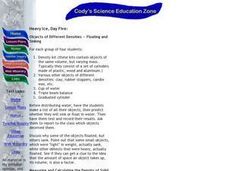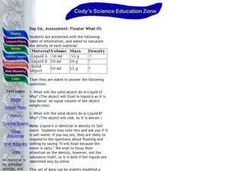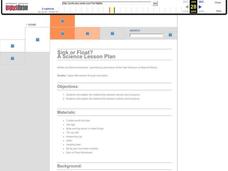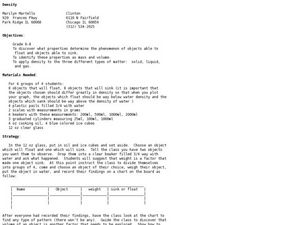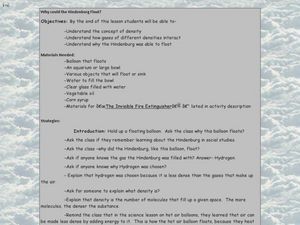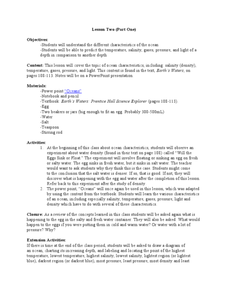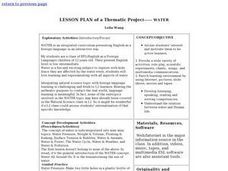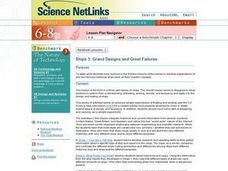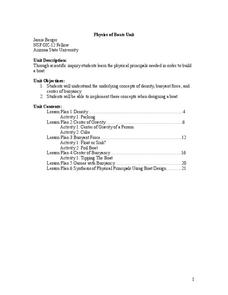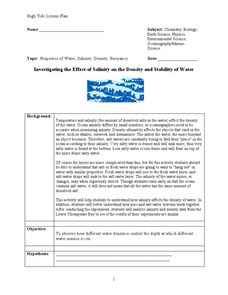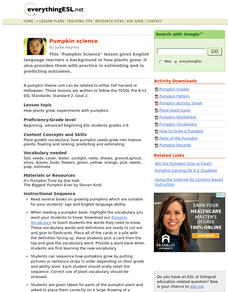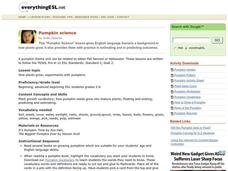Curated OER
Float Your Boat
Learners investigate buoyancy, displacement and density. In this flotation lesson students study the Archimedes' Principle, analyze data and draw conclusions.
CK-12 Foundation
Going Fishing
Why do some things float and others sink? A creative simulation allows learners to adjust mass and volume of an object to affect its buoyancy in water. A graph records the effect of each manipulation.
PBS
Reading Adventure Pack: Oceans
Flotsam by David Wiesner and The Magic School Bus on the Ocean Floor by Joanna Cole, illustrated by Bruce Degen, begin a reading adventure pack focusing on oceans. With story listening and thoughtful discussion, scholars complete several...
Curated OER
The Magical Diving Sub
Students use their background knowledge of how scientists work to discuss and predict if a given object will sink or float. They record their predictions on a data sheet. Students test the objects and organize them into floating or...
Curated OER
Heavy Ice: Day Five
Learners explore physics by conducting a class experiment. In this density lesson plan, students examine a list of items and discuss whether they will sink or float and then determine their density. Learners examine the objects over five...
Curated OER
Day Six: Floater What Ifs
Young scholars observe earth science by examining results from an experiment. In this buoyancy lesson, students practice floating different items in two different liquids and identify why certain objects will float and others sink. Young...
Curated OER
Water Exploration Station
Students explore the characteristics of water. In this water exploration lesson, students participate in various learning centers to inquire how water drains and how to increase the flow of water. Students use estimation and measurement...
Curated OER
Sink or Float?
Students analyze the relationship between density, buoyancy, and salinity. In this chemical properties lesson, students read a background activity for the lesson and experiments to the topics. Students discuss the questions and complete...
Curated OER
Density: Floating, Sinking, and Suspending
Students observe teacher demonstrations that illustrate density. For this density lesson, the teacher demonstrates how air bubbles in a carbonated drink can cause a raisin to float and how an egg sinks in fresh water, but floats in salt...
Curated OER
Density: Float or Sink
Students discover density. In this density lesson, students discover the properties of objects that allow them to float or sink in water.
Curated OER
The Role of Density in Sinking or Floating: Relational Causality
Students consider density and how it affects sinking and floating. Students make predictions, test liquids, and observe why some liquids sink and others float. They perform experiments to determine relational causality and how liquids...
Curated OER
Density and Buoyancy Lesson Plan
Young scholars investigate why some objects float or sink in water. In this physics lesson, students calculate the density of clay ball using a mathematical equation. They write a complete lab report about the experiment.
Curated OER
Why Could the Hindenburg Float?
Tenth graders experiment with floating and sinking objects and heavy and light liquids, using correct terms, like density, to explain what happens. In this Hindenburg lesson, 10th graders watch a demonstration called the invisible...
Curated OER
Lesson tow
Students study the ocean and its characteristics. In this oceans instructional activity students complete a lab activity and are able to predict temperature of certain depths.
Curated OER
How Does the USS Alabama Float?
Students investigate buoyancy. In this buoyancy lesson, students apply the Archimedes Principle of Buoyancy to the experiment conducted in class to determine how battleships float.
Curated OER
Lesson Plan of a Thematic Project - Water
Sixth graders investigate the properties of water. In this life science lesson, 6th graders create a concept map of water. They share their work with the class.
California Academy of Science
Buoyancy Bulls-Eye
Why does a seastar sink, but a jellyfish float? Through a fun investigation, learners examine the concept of buoyancy using simple household items. The challenge: create neutral buoyancy for an action figure in water. With ample...
Curated OER
Grand Designs And Great Failures
Students extend their understanding of floating, sinking, density, and buoyancy and apply it to the design and testing of ships. students discover that most ships are constructed very similarly-whether they are schooners or destroyers.
Curated OER
Ships 3: Grand Designs And Great Failures
Students engage in this, the third in a three-part series on ships. The overall lesson series is designed to allow students to extend their understanding of floating, sinking, density, and buoyancy and apply it to the design and testing...
Arizona State University
Physics of Boats
Let's go sailing! An instructive unit includes six lessons with multiple activities to teach scholars about density, center of gravity, buoyancy, and the Archimedes Principle. They can complete the final project of building a boat...
Curated OER
Investigating the Effect of Salinity on the Density and Stability of Water
Water with varying amounts of dissolved salt are dyed and then used to compare densities. The objective is to discover the effect of salinity, and therefore density, on ocean water on the stability of the ocean. Many branches of science...
Curated OER
Discussing How Plants Grow
Study how plants grow with your English language learners with a cross-curricular lesson revolving around pumpkins. These activities provide opportunities to practice new scientific vocabulary while practicing skills such as estimating...
Curated OER
Pumpkin Science
Here is a nice lesson, which includes some good worksheets, on pumpkins and how they grow. It is an ESL lesson designed for beginning and early intermediate young scholars. After listening to some books about pumpkins, learners label...
Center for Learning in Action
Properties of Balls
Enhance your states of matter lessons with a hands-on science investigation that compares six different balls' color, texture, size, weight, ability to bounce, and buoyancy.




